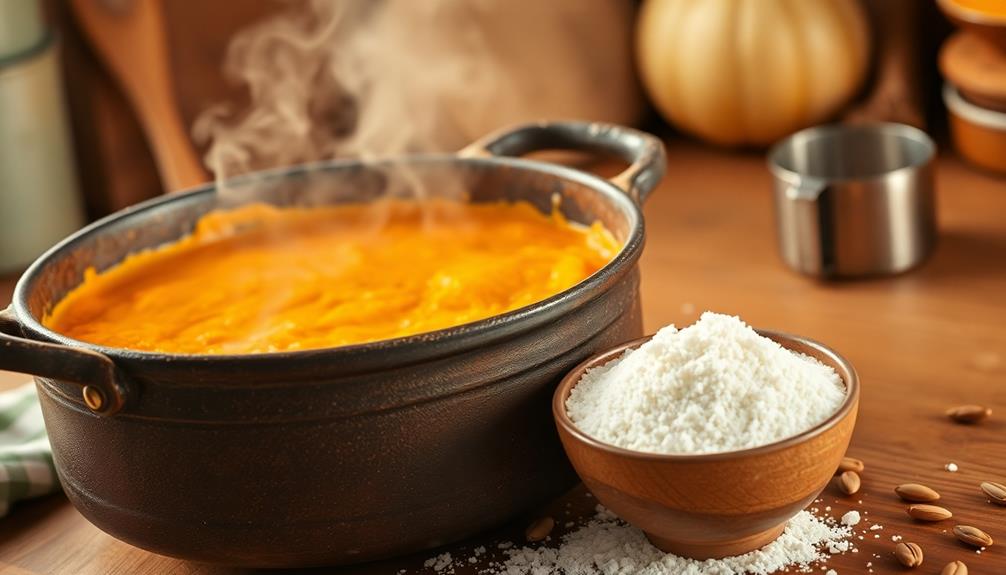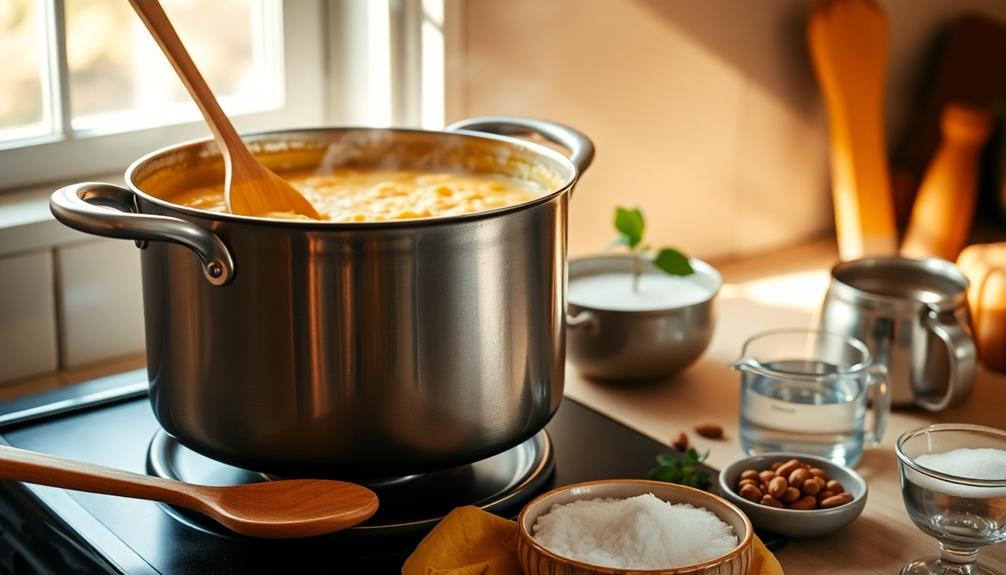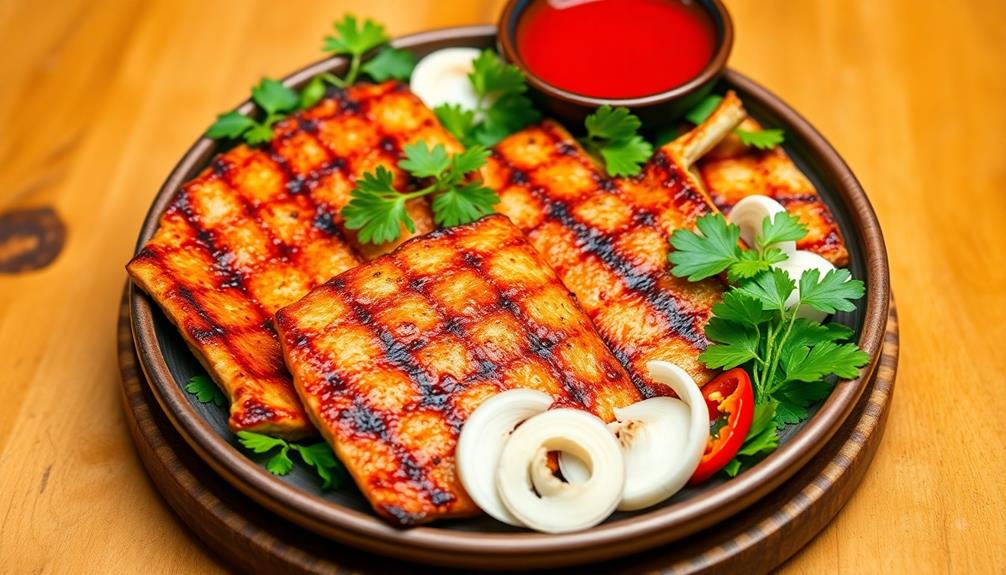Hobak Juk is a delightful Korean pumpkin porridge that's creamy, sweet, and perfect for chilly days! It's made with ripe pumpkin, sweet rice flour, and water, creating a warm and comforting dish that's easy to cook. You simply puree the pumpkin, mix in the flour, and simmer it until thick. Don't forget to taste it and add some honey or cinnamon for extra flavor! This dish isn't just yummy; it's also rich in nutrients, making it good for you, too. Invite some friends to join the fun in the kitchen, and there's even more to discover about Hobak Juk!
Key Takeaways
- Hobak Juk is a traditional Korean pumpkin porridge, symbolizing good luck and prosperity, often enjoyed during special occasions.
- The dish is made from pumpkin, sweet rice flour, and water, creating a creamy, nutrient-rich meal.
- It is naturally sweet and easy to digest, making it ideal for children and those feeling unwell.
- Toppings like toasted pumpkin seeds, nuts, and honey can enhance flavor and texture, promoting creativity in preparation.
- Hobak Juk can be enjoyed year-round, especially in autumn, as a comforting dish for any meal.
History
Hobak Juk, or pumpkin porridge, has roots that stretch deep into Korean culinary traditions. This delicious dish dates back hundreds of years, and it's been enjoyed by families for generations.
You might be surprised to learn that pumpkin porridge was often served during special occasions, like birthdays or holidays, because it symbolizes good luck and prosperity. Isn't that cool?
Back in the day, Korean farmers would harvest pumpkins in the fall, and they'd use these vibrant, orange vegetables to create a warm and comforting meal. The creamy texture of the porridge made it perfect for sharing with loved ones.
Plus, it's naturally sweet, which makes it a favorite among kids and adults alike!
You might also find it interesting that Hobak Juk is often eaten when someone is feeling under the weather. It's gentle on the stomach and packed with nutrients, making it a perfect food to help you feel better.
So, whether you're celebrating or just need a cozy meal, pumpkin porridge has a special place in Korean hearts and homes.
Next time you try it, think about the rich history and love that goes into each bowl!
Recipe
Hobak Juk, or pumpkin porridge, is a warm and creamy dish that originates from Korea. It's traditionally enjoyed during the autumn months when pumpkins are in season, but its comforting flavors make it a popular choice year-round. The dish isn't only delicious but also packed with nutrients, making it a wholesome option for breakfast or a light meal. The natural sweetness of the pumpkin blends beautifully with the rice and can be adjusted to personal taste, making it a versatile recipe that can be tailored to different diets.
Preparing Hobak Juk is a straightforward process, perfect for both novice and seasoned cooks. The key to a great porridge lies in the choice of pumpkin; a sweet variety like the Korean melon pumpkin (also known as 'daharang') is preferred but any sweet pumpkin will do. The cooking method involves simmering the ingredients together until they reach a velvety consistency, creating a wholesome dish that fills you with warmth.
Whether you enjoy it plain or topped with nuts and honey, Hobak Juk is sure to be a comforting addition to your culinary repertoire.
Ingredients:
- 1 medium-sized pumpkin (about 2-3 cups when peeled and cubed)
- 1 cup sweet rice (also known as 'glutinous rice' or 'chapssal')
- 4 cups water
- 1-2 tablespoons sugar (adjust to taste)
- Pinch of salt
- 1 teaspoon vanilla extract (optional)
- Nuts or seeds for topping (optional)
- Honey or syrup for drizzling (optional)
To prepare Hobak Juk, start by soaking the sweet rice in water for at least 2 hours (or overnight for best results). After soaking, drain the rice and set it aside. In a large pot, add the cubed pumpkin and water, and bring it to a boil. Cook the pumpkin until it's tender, which usually takes about 10-15 minutes.
Once the pumpkin is soft, use a blender or an immersion blender to puree the pumpkin until smooth. Return the pureed pumpkin to the pot, add the soaked rice, sugar, and a pinch of salt. Stir well, then bring the mixture to a gentle simmer, allowing it to cook for about 20-30 minutes, stirring occasionally to prevent sticking, until the porridge thickens and the rice is fully cooked.
For extra tips, consider adjusting the consistency of your porridge by adding more water if you prefer a thinner texture or cooking it longer for a thicker consistency. You can also enhance the flavor with a touch of vanilla extract during cooking.
If you want to make it more nutritious, try adding nuts or seeds on top as a garnish, and drizzle some honey or syrup for added sweetness. Hobak Juk can be stored in the refrigerator for a few days, and it reheats well, making it a convenient dish to prepare in advance. Enjoy the delightful taste and health benefits of this traditional Korean treat!
Cooking Steps
Now that you've got your ingredients ready, it's time to whip up some delicious Hobak Juk!
First, you'll prepare that smooth pumpkin puree, then mix in the sweet rice flour to give it a delightful texture.
After simmering until it thickens just right, you can add your favorite sweetener and top it off with crunchy toasted pumpkin seeds for a tasty finish!
Step 1. Prepare the Pumpkin Puree

To prepare the pumpkin puree, start by selecting a ripe pumpkin, ideally one that's small to medium-sized, as these tend to be sweeter and more flavorful.
Once you've got your pumpkin, it's time to wash it thoroughly to remove any dirt.
Next, carefully slice the pumpkin in half. You might want to ask an adult for help with this part, since pumpkins can be tough!
Scoop out the seeds and stringy bits inside; don't worry, you can save the seeds for roasting later if you'd like!
Now, cut the pumpkin into smaller pieces to make cooking easier. You can either steam, boil, or roast these pieces until they're soft.
If you choose to roast, preheat your oven to 400°F (200°C), place the pumpkin pieces on a baking sheet, and roast for about 30-40 minutes.
Once they're tender, let them cool a bit.
Step 2. Add Sweet Rice Flour

Next, you'll want to incorporate sweet rice flour into your pumpkin mixture for that signature creamy texture. This special flour is what makes your Hobak Juk extra smooth and delicious!
Start by measuring out about half a cup of sweet rice flour. It's super sticky, but that's what we want.
Now, take your pumpkin puree and slowly add the sweet rice flour to it. It's best to sprinkle it in gradually while stirring, so you don't end up with clumps.
Keep mixing until the flour is fully combined with the pumpkin. You'll notice the mixture getting thicker and creamier, which is just what you need for that cozy porridge vibe.
If you find the mixture too thick, don't worry! Just add a little water, broth, or milk to loosen it up. This way, you can achieve your desired consistency.
Remember, the goal is to create a smooth base that will hold all that yummy pumpkin flavor. So, keep stirring with a big smile, knowing you're on your way to making a delightful pumpkin porridge that everyone will love!
Who knew cooking could be this much fun?
Step 3. Simmer Until Thickened

Once your pumpkin and sweet rice flour mixture is well combined, it's time to heat things up. Pour the mixture into a pot and set it over medium heat. You'll want to stir it often, so grab a sturdy spoon and get ready to mix!
As the pot heats up, you'll notice the mixture starting to bubble gently—this is a good sign! Keep stirring, and soon enough, you'll see the mixture thicken. It's like watching a magic trick; one moment it's all runny, and then suddenly, it's creamy and smooth.
Don't rush this part, though! Let it simmer for about 10 to 15 minutes, stirring frequently. The more you stir, the better the flavor will develop, and it'll help prevent any sticking or burning at the bottom of the pot.
If you notice it getting too thick, you can always add a splash of water to loosen it up a bit. Just keep an eye on it, and soon you'll have a lovely, thick pumpkin porridge that's ready for the next step. Your kitchen will smell amazing, and you're one step closer to enjoying a delicious bowl of hobak juk!
Step 4. Incorporate Sweetener to Taste

How do you like your hobak juk? Sweet, comforting, and just the right amount of deliciousness, right?
Once your pumpkin porridge has thickened nicely, it's time to add a sweetener that suits your taste buds. You can use sugar, honey, or even maple syrup—whatever makes your sweet tooth dance with joy! Aromatherapy can also be a wonderful companion to your cooking experience, as certain scents can enhance your mood and make the process even more enjoyable, leading to a more satisfying meal preparation the benefits of aromatherapy.
Start by adding a tablespoon of your chosen sweetener to the pot. Stir it in gently, letting it dissolve completely. Then, take a tiny taste. If you want it sweeter, add another tablespoon. Keep tasting until it's just right for you! Remember, it's all about finding that perfect balance.
If you're feeling adventurous, you might also sprinkle in a pinch of cinnamon or a dash of vanilla extract to add some extra flavor. That'll make your hobak juk extra special!
As you stir and sweeten, picture yourself enjoying this warm, cozy dish on a chilly day, or maybe even sharing it with friends.
Once you've got it just how you like it, you'll be ready to take the next exciting step in creating the perfect pumpkin porridge. Enjoy the sweetness!
Step 5. Serve With Toasted Pumpkin Seeds

To elevate your hobak juk even further, serving it with toasted pumpkin seeds adds a delightful crunch and nutty flavor.
First, grab a handful of raw pumpkin seeds. They're usually found in the baking aisle or with the nuts. Preheat your oven to 350°F (175°C). Spread the seeds out on a baking sheet, making sure they're in a single layer. This helps them toast evenly.
Pop them in the oven for about 10 to 15 minutes, but keep a close eye on them! You want them golden brown, not burnt—unless you like your snacks extra crispy! Stir the seeds halfway through to ensure they toast evenly.
Once they're done, let them cool for a minute.
Now, sprinkle those magical toasted pumpkin seeds right on top of your warm hobak juk. Not only do they look pretty, but they also make every spoonful extra special. The creamy pumpkin porridge mixed with the crunchy seeds is like a party in your mouth!
Enjoy your delicious creation, and don't forget to share it with friends or family. They'll love the taste and the fun texture!
Final Thoughts
Enjoying Hobak Juk is more than just savoring a delicious dish; it's about embracing the comforting flavors of Korean cuisine. This delightful pumpkin porridge warms your heart and fills your belly, making it a perfect choice for chilly days. You can easily whip it up for breakfast, lunch, or even dinner, and it's a fantastic way to introduce your family to new flavors.
Plus, incorporating wholesome ingredients can provide numerous health benefits, similar to how certain foods can reduce uric acid levels in a gout-friendly diet.
When you take that first spoonful, you'll notice the creamy texture and the natural sweetness from the pumpkin. Plus, if you sprinkle some toasted pumpkin seeds on top, you'll add a crunchy twist that makes it even more exciting!
Hobak Juk isn't just tasty; it's also packed with nutrients, so it's great for keeping your energy up throughout the day.
Don't forget, cooking should be fun! Get creative by adding your favorite toppings or spices. You can even invite friends to join in the cooking process, turning it into a fun activity.
Frequently Asked Questions
What Are the Health Benefits of Hobak Juk?
You'll discover that many foods can boost your health. They often provide essential nutrients, support digestion, and enhance immunity. Incorporating a variety of these nourishing options into your diet can lead to overall well-being.
Can I Use Other Types of Squash Instead of Pumpkin?
Absolutely, you can use other types of squash instead of pumpkin! Varieties like butternut or acorn squash will offer a similar texture and sweetness, enhancing your dish while providing unique flavors. Enjoy experimenting with different squashes!
How Long Does Hobak Juk Last in the Fridge?
You can keep it in the fridge for about three to four days. Just make sure it's stored in an airtight container to preserve its flavor and texture, and reheat before enjoying.
Is Hobak Juk Suitable for Gluten-Free Diets?
Yes, it's suitable for gluten-free diets! You'll find that many pumpkin porridge recipes use rice flour or no flour at all, ensuring you can enjoy this comforting dish without any gluten-related concerns. Enjoy!
What Are Common Toppings or Add-Ins for Hobak Juk?
When enjoying a warm, comforting dish, you might consider toppings like nuts, seeds, or dried fruits. You could also add a drizzle of honey or a sprinkle of cinnamon for extra flavor and texture.









